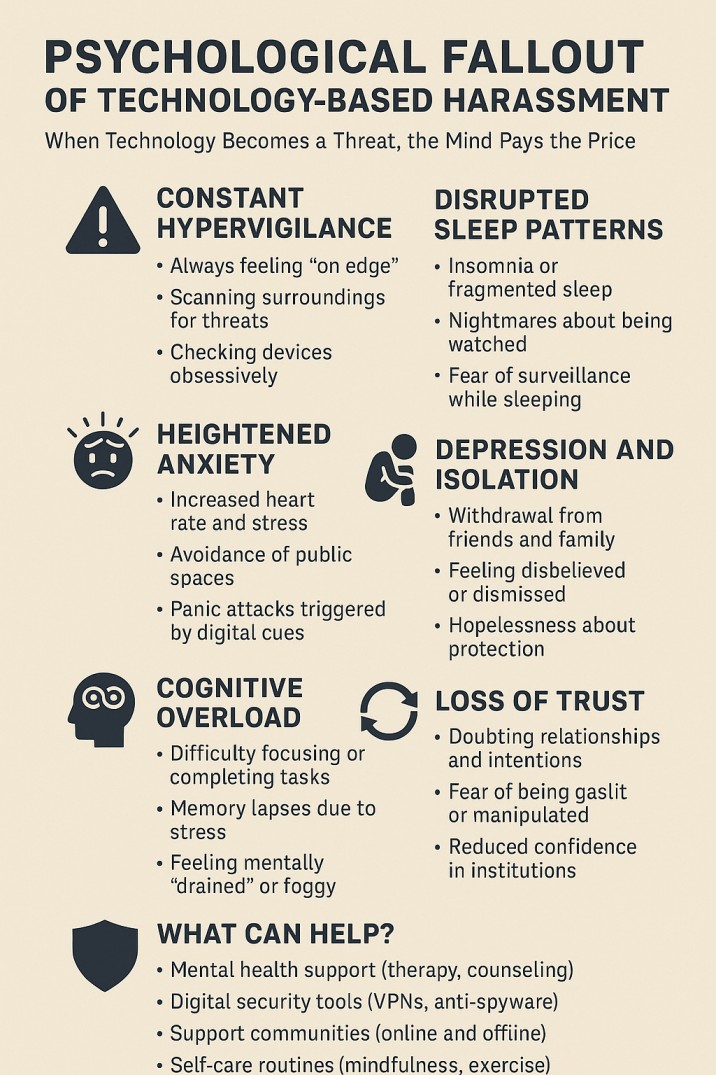In recent years, the term “targeted individuals” has gained increasing attention in both online forums and academic discussions. It refers to people who believe they are being systematically surveilled, stalked, or harassed through digital and physical means. For some, this label is a stark reflection of personal reality; for others, it’s a misunderstood phenomenon often dismissed or ridiculed. But one thing is clear: digital harassment is on the rise, and the stories of targeted individuals are becoming too widespread to ignore.
The Role of Technology in Harassment
Technology, once a symbol of empowerment and connection, has increasingly become a double-edged sword. At the core of modern harassment lies the relentless pace of technological advancement, which—while offering unprecedented convenience—has also created new avenues for intrusion, manipulation, and surveillance.
A Digital Ecosystem Built for Observation
We live in an era where smartphones serve as our lifelines to the digital world. Yet, they also double as personal tracking devices. With built-in GPS, microphones, and cameras, these tools can be repurposed for invasive surveillance. Many targeted individuals report incidents where they believe their phone calls are being monitored or conversations recorded. Some even claim to notice their devices activating at odd times or draining battery abnormally fast—signs often associated with unauthorized access.
Social Media as a Tool for Tracking and Targeting
Social platforms that promise connection also harvest an immense amount of behavioral data. Likes, comments, search history, and even pauses while scrolling feed into algorithms designed to predict and influence behavior. For targeted individuals, this creates a perception of being watched or profiled—sometimes reinforced by contextually eerie ad placements or friend suggestions. In extreme cases, some report receiving direct messages or posts that reference private information never shared online.
The Rise of Digital Stalking and Remote Harassment
Unwanted attention has evolved beyond physical proximity. Cyberstalking is now a global threat, with perpetrators able to monitor, intimidate, or impersonate from thousands of miles away. Spoofed numbers, anonymous emails, and repeated friend requests from unfamiliar accounts contribute to a growing sense of vulnerability. For victims, distinguishing between random spam and calculated harassment becomes nearly impossible.
Surveillance Tech and the Erosion of Privacy
Public and private entities alike have embraced surveillance technologies for security purposes—CCTV cameras, facial recognition software, license plate readers—but these tools can also be used maliciously. Individuals who believe they are being targeted often describe seeing the same cars, people, or drones repeatedly. While skeptics might dismiss these concerns as coincidental, the pattern-recognition built into our brains tells a more disturbing story. Whether real or perceived, the sense of being watched is mentally exhausting.
The Psychological Fallout

Regardless of whether harassment is confirmed or imagined, the mental toll is significant. Constant hypervigilance can lead to anxiety, sleep disturbances, social withdrawal, and depression. Victims may feel isolated, disbelieved, or labeled as unstable when they attempt to explain their experiences. The uncertainty surrounding technological harassment blurs the line between paranoia and reality, often intensifying emotional distress.
Technology as Both Weapon and Lifeline
Ironically, the same technologies that facilitate harassment can also offer avenues for support. Encryption tools, anti-spyware apps, and secure messaging platforms help individuals regain a sense of control. Online forums and advocacy groups provide validation and community. However, the road to reclaiming digital autonomy is often long, and the balance of power remains uneven.
Social and Psychological Dimensions
The rise of targeted individuals intersects with several other societal trends, including mental health, disinformation, digital privacy erosion, and surveillance capitalism. As our lives become more entangled with digital ecosystems, the vulnerabilities multiply. A compromised social media account or leaked phone number can become the catalyst for months of stalking, blackmail, or identity manipulation. And while cyberbullying has long been a recognized issue, the harassment faced by targeted individuals is often more covert, prolonged, and psychologically destabilizing.
The Elusiveness of Digital Evidence
Digital harassment manifests in ways that are hard to document, let alone prove. Unlike overt threats or visible trolling, targeted individuals often face subtler forms of harassment: manipulated search engine results, persistent spam messages, hacked smart devices, and coordinated smear campaigns. The ambiguous nature of this harassment makes it difficult for victims to find recourse. Law enforcement agencies are frequently ill-equipped or unwilling to investigate what they consider “fringe” claims, leaving targeted individuals isolated and desperate for validation.
Community, Support, and Online Dynamics

Social media has served both as a lifeline and a minefield for targeted individuals. On one hand, online communities offer support, shared experiences, and survival strategies. On the other, they can amplify fear, spread unverified claims, and foster echo chambers where suspicion intensifies. The internet, in many ways, has become the primary battlefield for targeted individuals. It is here they seek justice, document incidents, and try to reclaim a sense of agency.
Mental Health Considerations and Nuanced Understanding
Yet, it’s essential to approach this issue with nuance. Not all who identify as targeted individuals are experiencing the same thing. For some, it’s a justified response to persistent digital abuse or stalking. For others, it may reflect deeper psychological struggles, including delusional disorders or trauma-induced paranoia. Mental health professionals are often placed in a challenging position, having to distinguish between credible claims and symptoms of mental illness—without invalidating the person’s suffering.
The Reluctance to Confront Reality
The broader societal reluctance to address the experiences of targeted individuals often stems from discomfort. It’s easier to attribute their accounts to fantasy than to confront the dark potential of our interconnected world. But ignoring their voices can be dangerous. Even in cases where mental illness plays a role, these individuals deserve compassion, care, and safety—not dismissal. The rise in reports of being targeted coincides with real trends: increased data breaches, more sophisticated spyware, and corporate or governmental surveillance programs that erode personal privacy.
Legal Gaps and Institutional Inertia
Legal systems are only beginning to grapple with the implications of digital harassment. There is a growing push for laws that recognize the psychological damage caused by persistent digital intrusion. However, until regulations catch up, targeted individuals often have little protection. Traditional restraining orders offer minimal shield against IP tracking or GPS-based surveillance. As a result, some victims resort to extreme self-isolation, abandoning digital devices altogether, or moving homes multiple times in hopes of escaping their perceived tormentors.
Technology Platforms and Responsibility
Technology companies, meanwhile, bear part of the responsibility. Platforms that enable anonymous messaging, location sharing, or facial recognition can inadvertently become tools for harassment. The lack of robust user protections and the sluggish response to abuse reports only exacerbate the issue. For targeted individuals, these technological vulnerabilities aren’t hypothetical—they’re real risks that fuel daily anxiety.
AI, Surveillance, and Digital Mistrust
To make matters worse, the rise of AI and algorithmic profiling has created a new layer of unease. Some targeted individuals believe they’re being subjected to predictive policing or behavior modeling that tracks their actions across platforms and locations. While this may sound like science fiction, real-world examples of algorithmic surveillance being used in oppressive ways are well documented. These developments only deepen the mistrust that many targeted individuals feel toward digital infrastructure.
Misinformation and the Erosion of Credibility
The digital age, while offering unprecedented access to information, has also birthed a parallel epidemic—misinformation. For targeted individuals, this presents a unique and often devastating challenge. When the line between fact and fiction is blurred, legitimate cries for help are drowned out by a flood of baseless speculation.
The Conflation Problem
Many credible reports of digital harassment or surveillance are quickly overshadowed by outlandish theories. Claims involving government satellites tracking thoughts, alien technologies, or clandestine global orders often circulate alongside firsthand accounts of stalking, doxxing, or cyber-interference. The proximity of these two kinds of narratives leads to what psychologists call conflation—where audiences are unable to distinguish between the plausible and the implausible. As a result, the credibility of all claims, valid or not, is called into question.
The Media’s Role in Distortion
Mainstream and fringe media alike often sensationalize these stories for clicks and attention. Headlines emphasize the bizarre elements while ignoring the very real psychological trauma and technical vulnerabilities involved. This approach reinforces a dismissive attitude, painting all targeted individuals with the same conspiratorial brush—thus compounding their isolation.
Disincentivizing Support and Advocacy
Perhaps most troubling is the ripple effect misinformation has on support systems. Professionals such as therapists, IT experts, and legal advisors may hesitate to offer support or advocacy for victims, fearing association with fringe or irrational beliefs. This stigma stifles open discussion, silences those genuinely affected, and hinders the advancement of policies and technical safeguards that could offer real protection.
The Need for Discernment
To move forward, society must adopt a more discerning lens. Not every claim fits neatly into the realm of paranoia, nor does every complaint stem from fantasy. By distinguishing evidence-based reports from speculative or theatrical ones, we can begin to rebuild trust, validate real experiences, and encourage meaningful intervention.
Toward a Cultural and Legal Shift
Nonetheless, a cultural shift is beginning to take place. Advocacy groups focused on digital rights and anti-surveillance activism are starting to engage with the stories of targeted individuals. Academics, too, are exploring the phenomenon through multidisciplinary lenses—combining psychology, criminology, and digital ethics. These efforts aim not to sensationalize, but to understand. They acknowledge that the digital age has introduced new forms of vulnerability, and the experiences of targeted individuals, no matter how complex, deserve investigation.
Rethinking the Question
As digital harassment evolves, the conversation must expand beyond simplistic labels. It’s not enough to ask whether someone is “really” being targeted. The focus should shift to what systems enable harassment, how victims can be protected, and what ethical responsibilities corporations and governments hold in this landscape. In that way, we move from skepticism to solutions.
Conclusion
Ultimately, whether the experiences of targeted individuals stem from malicious networks, algorithmic surveillance, or psychological distress, the pain they feel is real. Their stories are windows into a future where digital and personal security are inseparable. Listening with empathy—and responding with policy—may be our only path forward.
Andrea Balint is a writer and researcher focused on human behavior, workplace psychology, and personal growth. Through her work at CareersMomentum, she explores how mindset, leadership, and emotional intelligence shape modern careers. With a background in communication and HR development, she transforms complex ideas into practical insights that help readers build clarity, confidence, and professional purpose.
